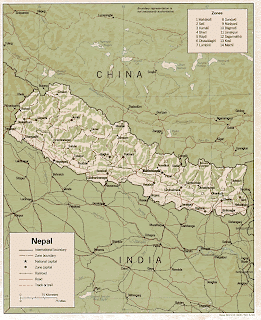
On Monday, Nepal’s president, Ram Baran Yadav, backed the choice to continue the tradition of Royal Kumari. The Royal Kumari, or sacred virgin, is a chosen girl who is to be referred to as a living goddess. To become Kumari, a girl of 3 years of age must meet 32 very strict criteria. Some of these 32 are:
1. She must be a Buddhist from the Newar Shakya caste (where Buddha belonged)
2. She must be in excellent health
3. She must have never have shed blood or been afflicted by any disease
4. She must be without blemish
5. She must have not lost any teeth
6. She must have the neck of a conch shell
7. She must have the body like a banyan tree
8. She must have eyelashes like a cow
9. She must have thighs like a deer
10. She must have a chest like a lion
11. She must have a voice soft and clear as a duck
12. Her hair must be black
13. Her eyes must be black
14. She must have dainty hands and feet
15. She must have a set of twenty teeth
16. She must have small and well-recessed sexual organs
17. She must be fearless

The Royal Kumari is a living goddess in Nepal. Kumari was the name of the goddess Durga as a child, the supreme goddess. The legend of why there is a Kumari comes from the story of King Jayaprakash Malla and the red serpent. The story tells of the King who played a dice game with the goddess Taleju while a red serpent watched the game played. The goddess and the King played this game every night and the King’s wife got jealous and demanded that he never see the goddess again. The goddess was angered She told the King that she would be resurrected as a virgin child and he must protect her for all eternity. The King then sent a search out for the little girl in hopes of protecting the goddess’s spirit.
It is legend today, that if a mother in Nepal saw a red serpent or dreams of one, her daughter could be considered the next Kumari. Kumari’s are selected at a very young age and only when they menstruate is when it is believed that the soul of the goddess leaves the body and goes to the next Kumari. The selection process to find the new Kumari is down by 5 senior Buddhist priests and she must past all 32 criteria.
Every action that the Kumari does is watched and then translated. When she has visitors, they are allowed to touch her feet and see how she responds to them. If she does respond in any way, it is translated as followed:
Crying – serious illness or death
Rubbing eyes – imminent death
Trembling – imprisonment
Hand clapping – reason to fear the king
Picking at food – Financial losses

What is the big controversy now? Now that Nepal is a republic ran by an atheist government (Maoist), there are speculation from citizens and leaders on why to continue with the tradition of Kumari. With the new presidents permission, the tradition will live on despite some objection. However, with the new form of government comes a new form of Kumari. The Nepal Supreme Court just ruled that the Kumari is welcome to attend school and rid of her confinement in the castle.
The new Kumari that has been picked is three years old, Matine Shakya, who will replace Kumari Preeti Shakya, 12. The current Kumari is nearing puberty and becoming more and more ritually unclean.

Once one cannot be a Kumari anymore, it takes 4 days to rid her of her post and she is then paid 6000 rupees per month. This is four times the amount of average income in the poverty stricken Nepal.
List of former Kumaris
Name Hometown Dates as Kumari Marital Status
Hira Maiya Shakya Wotu 1922-1923 married, 0 children
Chini Shova Shakya* Lagan 1923-1931 married, 2 daughters
Chandra Devi Shakya* Asonchuka 1931-1933 married, 2 daughters
Dil Kumari Shakya Lagan 1933-1942 married, 3 sons ,1 daughter
Nani Shova Shakya Ombahal 1942-1949 married, 4 sons, 2 daughters
Kayo Mayju Shakya* Kwahiti 1949-1955 married, 1 son, 1 daughter
Harsha Laxmi Shakya Naghal 1955-1961 married, 2 sons
Nani Mayju Shakya Naghal 1961-1969 married, 1 son, 2 daughters
Sunina Shakya Ombahal 1969-1978 married, 1 son, 1 daughter
Anita Shakya Sikamoobahal 1978-1984 unmarried
Rashmila Shakya Kwahiti 1984-1991 unmarried
Amita Shakya Asanbahal 1991-2001 unmarried
Preeti Shakya Itumbahal 2001-2007 unmarried

